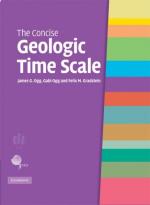|
This section contains 312 words (approx. 2 pages at 300 words per page) |
| Geologic Time Scale | ||||
| Era | Period | Epoch | Significant Events | Million Years Before Present |
| Cenozoic | Quartenary | Holocene | recorded human history, rise and fall of civilizations, global warming, habitat destruction, pollution mass extinction | 0.01 |
| Pleistocene | Homo sapiens, ice ages | 1.6 | ||
| Tertiary | Pliocene | global cooling, savannahs, grazing mammals | 5.3 | |
| Miocene | global warming, grasslands, Chalicotherium | 24 | ||
| Oligocene | 37 | |||
| Eocene | modern mammals flourish, ungulates | 58 | ||
| Paleocene | 66 | |||
| Mesozoic | Cretaceous | last of age of dinosaurs, modern mammals appear, flowering plants, insects | 144 | |
| Jurassic | huge plant-eating dinosaurs, carnivorous dinosaurs, first birds, breakup of Pangea | 208 | ||
| Triassic | lycophytes, glossopterids, and dicynodonts, and the dinosaurs | 245 | ||
| Paleozoic | Permian | Permian ends with largest mass extinction in history of Earth, most marine inverterbrates extinct | 286 | |
| Pennsylvanian | vast coal swamps, evolution of amniote egg allowing exploitation of land | 320 | ||
| Missipian | shallow seas cover most of Earth | 360 | ||
| Devonian | vascular plants, the first tetrapods, wingless insects, arachnids, brachiopods, corals, and ammonite were also common, many new kinds of fish appeared | 408 | ||
| Silurian | Coral reefs, rapid spread of jawless fish, first freshwater fish, first fish with jaws, first good evidence of life on land, including relatives of spiders and centipedes | 438 | ||
| Ordovician | most dry land collected into Gondwana, many marine invertebrates, including graptolites, trilobites, brachiopods, and the conodonts (early vertebrates), red and green algae, primitive fish, cephalopods, corals, crinoids, and gastropods, possibly first land plants | 505 | ||
| Cambrian | most major groups of animals first appear, Cambrian explosion | 570 | ||
| Proterozoic | stable continents first appear, first abundant fossils of living organisms, mostly bacteria and archeobacteria, first eukaryotes, first evidence of oxygen build-up | 2500 | ||
| Archean | atmosphere of methane, ammonia, rocks and continental plates began to form, oldest fossils consist of bacteria microfossils stromatolites, colonies of photosynthetic bacteria | 3800 | ||
| Hadean | pre-geologic time, Earth in formation | 4500 | ||
Bibliography
Foster, Robert. Geology. 3rd ed. Columbus, OH: Charles E. Merrill, 1976.
Stanley, Stephen. Earth and Life Through Time. New York: W. H. Freeman, 1989.
Toulmin, Stephen and June Goodfield. The Discovery of Time. New York: Harper & Row, 1965.
Internet Resources
|
This section contains 312 words (approx. 2 pages at 300 words per page) |


